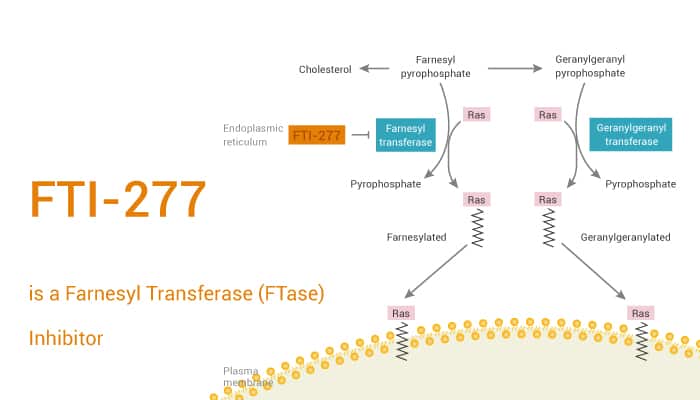Farnesyl transferase (FTase) is a zinc-dependent enzyme. It adds a 15-carbon isoprenoid called a farnesyl group to proteins bearing a CaaX motif. FTase regulates the activation of oncogenic Ras protein and consequently affects intracellular signal transduction, and cell proliferation. Ras-induced malignant transformation requires Ras farnesylation, a lipid posttranslational modification catalyzed by FTase. FTase inhibitors selectively inhibit farnesylation of a number of intracellular substrate proteins such as Ras. In addition, FTase inhibitors target signal transduction pathways responsible for the proliferation and survival of diverse malignant cell types.
FTI-277, the methyl ester derivative of FTI-276, is a farnesyl transferase (FTase) inhibitor. FTI-277 is a highly potent Ras CAAX peptidomimetic which antagonizes both H-Ras and K-Ras oncogenic signaling. In H-Ras oncogene-transformed NIH 3T3 cells, FTI-277 induces the accumulation of Ras-Raf complexes in the cytoplasmic. And then FTI-277 activates the serine/threonine kinase c-Raf-1 in cells transformed by farnesylated Ras (H-RasF). FTI-277 does not affect the activity of geranylgeranylated, Ras (H-RasGG). Moremore, FTI-277 blocks constitutive activation of MAPK in H-RasF. Besides, FTI-277 also inhibits carcinogenic K-Ras4B processing and constitutive activation of MAPK at higher concentrations. Furthermore, FTI-277 also can inhibit tumor growth in nude mice of a human lung carcinoma that has a K-Ras mutation and a p53 deletion.

In addition to the above, FTI-277 also inhibits hepatitis delta virus (HDV) infection. FTI-277 prevents the production of complete, infectious HDV virions of HDV genotype I and HDV genotype III virions.
To sum up, farnesyl transferase inhibitor FTI-277 selectively blocks oncogenic Ras signaling.
References:
[1] E C Lerner, et al. J Biol Chem. 1995 Nov 10;270(45):26802-6.
[2] Bruno B Bordier, et al. J Virol. 2002 Oct;76(20):10465-72.